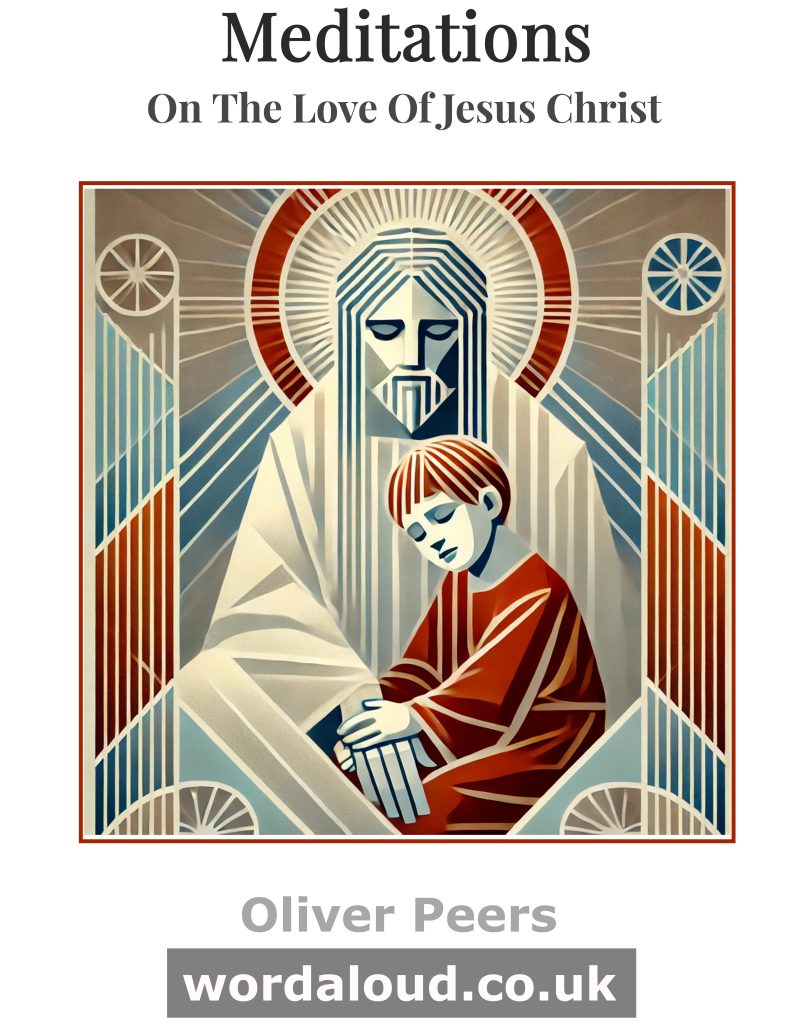Christian Art | Jesus And Saint Peter
The Gospel Of Saint John 21: 15-19 | King James Audio Bible KJV | Eastertide Friday 7
15 ¶ So when they had dined, Jesus saith to Simon Peter, Simon, son of Jonas, lovest thou me more than these? He saith unto him, Yea, Lord; thou knowest that I love thee. He saith unto him, Feed my lambs.
16 He saith to him again the second time, Simon, son of Jonas, lovest thou me? He saith unto him, Yea, Lord; thou knowest that I love thee. He saith unto him, Feed my sheep.
17 He saith unto him the third time, Simon, son of Jonas, lovest thou me? Peter was grieved because he said unto him the third time, Lovest thou me? And he said unto him, Lord, thou knowest all things; thou knowest that I love thee. Jesus saith unto him, Feed my sheep.
18 Verily, verily, I say unto thee, When thou wast young, thou girdedst thyself, and walkedst whither thou wouldest: but when thou shalt be old, thou shalt stretch forth thy hands, and another shall gird thee, and carry thee whither thou wouldest not.
19 This spake he, signifying by what death he should glorify God. And when he had spoken this, he saith unto him, Follow me.
Jesus has told Peter that he is to be the chief among the Apostles, the primate of the Church. During the Passion, Peter denied Jesus three times. It is perhaps for this reason that Jesus now gives Peter three opportunities to declare his love for him, three times to atone for his triple denial. Each time, Jesus responds with the command to lead the Church: ‘Feed my lambs… Feed my sheep.’ Peter and his successors are to be shepherds of the whole Church, imitating Jesus as Jesus declared himself to be in the parable of the Good Shepherd.
When Jesus asks Peter whether he loves him, he is teaching us again about the core truth of Christianity, which is to love. We are to love God with all our heart, with all our soul, with all our strength, with all our mind. We are to love one another as God has loved us. Such love represents a complete way of life, of selflessness and service to others, always looking toward what is good for each other, giving ourselves to each other. Those such as Peter who lead the Church may have to give most. All Christians, however, have Christ’s example to guide them. After all, in these verses of the Bible, Jesus has just prepared breakfast for the disciples. He has fed his sheep.
Peter, the third time he is asked, commits himself wholly to Christ’s mercy and knowledge of everything he, Peter, thinks and feels, of all that he carries inside himself. This is a perfect surrender to Jesus. What more can he say to Jesus, knowing that Jesus knows everything? There is great faith here, and we see the mutuality of the love between Peter and Jesus.
Jesus tells Peter how he has matured as a person, and too what his life will hold. When he was younger, Peter could go wherever he would. Now his call to loving obedience, to service, will lead him along a greater path. There is a tradition that both Peter and Paul suffered martyrdom in Rome during Nero’s persecution of Christians between the years 64 and 68, Peter dying by crucifixion, head downward. In this he followed Christ, and Peter’s death glorified God. His was complete love and selfless service.
‘This gift which is in Christ is one, yet offered, and offered in its fullness, to everyone. Always available, it is given in proportion to each one’s will to receive; it remains with each according to his will to grow in merit. This is what is with us to the end of time; this is our consolation in our time of waiting; this, through what it bestows and effects, is the pledge of our hope for the future; this is the light of our minds, the splendour of our understanding.’ St Hilary
King James Audio Bible | Endnotes
Do You Love Me? | Primacy And Martyrdom Of Saint Peter
In the original Greek text, the verb for ‘love’ that Jesus uses is agapao, which denotes a selfless, sacrificial love. In Peter’s responses, however, he uses the verb phileo, which can be translated as ‘to have affection for’ or ‘to be fond of’. This difference in language has led scholars and theologians to interpret the exchange between Jesus and Peter as a challenge to Peter’s commitment to Christ and his willingness to sacrifice himself for the sake of the Gospel.
Pope Benedict XVI in his book Jesus of Nazareth: Holy Week offers the following interpretation:
‘Jesus’ three questions about love, and Peter’s three responses, form a sort of examination that the Lord administers to Peter after his triple denial. In this way, Jesus gives Peter the opportunity to make up for his previous failing by professing his love for the Lord in a way that is no longer based on his own self-assurance, but on the Lord’s own word.’ Pope Benedict XVI, Jesus of Nazareth: Holy Week.
Here, Pope Benedict emphasizes the redemptive aspect of Jesus’ questioning of Peter, and the opportunity that it presents for Peter to reaffirm his commitment to Christ.
The passage foretells Peter’s martyrdom. According to tradition, Peter was crucified upside-down in Rome during the reign of Emperor Nero, choosing to suffer a gruesome death rather than renounce his faith in Christ.
The primacy of Saint Peter among the Apostles is a topic of much debate and discussion within both Catholic and Protestant circles. According to Catholic doctrine, Peter was given a special role as the leader of the early Christian community, and this authority has been passed down through the centuries through the apostolic succession. Many Protestant scholars, however, view this claim with skepticism and argue that Peter’s role was not fundamentally different from that of the other Apostles.
One Catholic theologian who has written extensively on the topic of Peter’s primacy is St. John Chrysostom, who in his Homilies on the Gospel of Matthew offers the following interpretation:
‘For he [Peter] was appointed to be the mouthpiece of the disciples, and the head of the choir… He was entrusted with the keys of heaven, which Christ gave to him alone.’ Saint John Chrysostom, Homilies on the Gospel of Matthew.
Here, St. John Chrysostom emphasizes the special authority that Peter was believed to have been given by Christ, and the unique role that he played in the early Christian community.
Primacy Of Saint Peter
To expand further on the topic of Peter’s primacy among the Apostles and the development of the doctrine of apostolic succession, it is important to look at the writings of other influential figures in the history of Christianity.
One such figure is St. Irenaeus of Lyons, a second-century bishop and theologian who is known for his defence of orthodox Christian doctrine against various heresies of his time. In his work Against Heresies, St. Irenaeus writes:
‘Since, however, it would be very tedious, in such a volume as this, to reckon up the successions of all the Churches, we do put to confusion all those who, in whatever manner, whether by an evil self-pleasing, by vainglory, or by blindness and perverse opinion, assemble in unauthorized meetings; [we do this, I say,] by indicating that tradition derived from the apostles, of the very great, the very ancient, and universally known Church founded and organized at Rome by the two most glorious apostles, Peter and Paul.’ – Staint Irenaeus, Against Heresies.
Here, St. Irenaeus appeals to the tradition of apostolic succession as a means of identifying the true Church and distinguishing it from those who gather in ‘unauthorized meetings’. He specifically emphasizes the role of Peter and Paul in founding and organizing the Church at Rome, and suggests that their authority has been passed down through the centuries to the bishops who have succeeded them.
Similarly, St. Cyprian of Carthage, a third-century bishop and martyr, wrote extensively on the topic of apostolic succession and the role of the bishop in the Church. In his work ‘On the Unity of the Church,’ St. Cyprian argues that the Church is ‘one, which is founded by the Lord’s authority upon Peter’, and that this unity is maintained through the succession of bishops:
‘The episcopate is one, each part of which is held by each one for the whole. The Church is one, which is spread abroad far and wide into a multitude by an increase of fruitfulness. As there are many rays of the sun, but one light; and many branches of a tree, but one trunk upheld by its tenacious root; and since from one spring flow many streams, although the multiplicity seems diffused in the liberality of an overflowing abundance, yet the unity is still preserved in the source.’ Saint Cyprian, On the Unity of the Church.
Here, St. Cyprian emphasizes the unity of the Church and the role of the bishop as a unifying force, with each bishop holding a part of the episcopate for the whole. He also explicitly links this unity to the authority of Peter, suggesting that the succession of bishops represents a continuation of the authority that was first given to Peter by Christ.
Saint Peter’s Relationship With Jesus
To further expand on the topic of Peter’s relationship with Jesus, it is worth exploring further the use of the Greek verb for ‘love’ in John 21:15-19 and its various nuances of meaning.
In the passage, Jesus asks Peter three times whether he loves him, and Peter responds affirmatively each time. However, the Greek verb for ‘love’ that Jesus uses in the first two questions is agape, which typically refers to a selfless, sacrificial love, while Peter responds with the verb phileo, which typically refers to a more affectionate, brotherly love. In the third question, Jesus uses the verb phileo, perhaps to meet Peter at his own level.
Saint Augustine of Hippo, a fourth-century theologian and Church Father, writes:
‘He asks him concerning his love, and he that thrice denied him thrice confesseth his love. But the Lord condescended even to the infirmity of his servant, and adapted his question to him, and used the same word which he had used.’ – Saint Augustine, Tractate 122 on John.
Saint Augustine suggests that Jesus is adapting his question to Peter’s level of understanding and meeting him where he is at. He also emphasizes the significance of Peter’s three-fold confession of love, which contrasts with his three-fold denial of Jesus prior to the crucifixion.
Similarly, Saint Thomas Aquinas, a thirteenth-century theologian and Doctor of the Church, writes:
‘Christ asks Peter three times, in order to commend the three-fold confession of faith which he was soon to make. He asks him about love, because love is the source of every virtue.’ Saint Thomas Aquinas, Catena Aurea on John 21.
Here, Saint Thomas emphasizes the importance of love as the source of virtue, and suggests that Jesus is testing Peter’s love in order to prepare him for the role he will play in spreading the Gospel.
In addition to the significance of the language used in the passage, it is also worth considering the historical context in which it was written. According to tradition, Peter was eventually martyred for his faith, and his willingness to die for Christ can be seen as a testament to the love and commitment he professed in this passage. This interpretation is echoed by Saint Bede the Venerable, an eighth-century monk and historian, who writes:
‘Peter, being questioned three times by the Lord, and receiving three replies of love, obtained the grace of not denying him in his passion. For he who had thrice denied him with oaths, now thrice affirmed his love with solemn protestations.’ Saint Bede, Commentary on the Gospel of John.
Here, St. Bede emphasizes the connection between Peter’s three-fold confession of love and his eventual faithfulness in the face of persecution.
In Catholic tradition, Peter has a special primacy among the apostles, based on Jesus’ words in Matthew 16:18-19 where he says to Peter: ‘You are Peter, and on this rock I will build my church…I will give you the keys of the kingdom of heaven.’ This passage is often interpreted as Jesus appointing Peter as the first pope and giving him special authority over the church. This is a central tenet of Catholicism.
At risk of over-simplifying, Protestant tradition does not see Peter as having a special primacy over the other Apostles or as the first pope. Instead, Protestantism emphasizes the priesthood of all believers and the direct relationship between each individual believer and God.
Martyrdom Of Saint Peter
In terms of Peter’s martyrdom, it is believed by many that Peter was crucified upside down in Rome during the reign of Emperor Nero. This tradition is supported by early Christian writings such as the Acts of Peter and the writings of the church fathers Tertullian and Origen.
Tertullian, who lived in the 2nd and 3rd centuries, wrote in his work Scorpiace about how Peter was crucified upside down:
‘But Peter, who had been bound by him, was hung up on a cross, and, when he was already dying, was crucified with his head towards the ground, his feet being raised on high, thinking thus to affront him. What a spectacle was there, brethren, which the world itself, however much it may despise us, must still wonder at! What kind of athletes then, do we reckon those who were crowned in such a contest?’
Origen, who lived in the 3rd century, also wrote about Peter’s martyrdom and how he requested to be crucified upside down out of humility:
‘Peter is said to have been crucified at Rome with his head downwards, as he himself had desired to suffer in that manner. […] But he judged himself unworthy to be crucified in the same manner as his Lord.’








